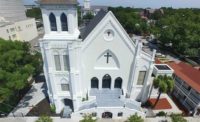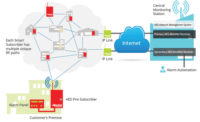Security dealers and integrators have been securing churches for decades, but the demand has picked up in recent years, spurred largely by mass shootings in 2015 at the Emanuel African Methodist Episcopal Church (also known as Mother Emanuel) in Charleston, S.C., and in 2017 at First Baptist Church in Sutherland Springs, Texas.
“Churches are always open with large groups of people gathering,” says Chip Shiver, president of Dayton, Ohio-based Shiver Security Systems, which operates as Sonitrol of SW Ohio. “With the mass shootings happening, I believe church leaders recognize the potential threat.”
Like many commercial customers, when it comes to security, churches tend to think of video and access control technologies, both of which are important parts of overall protection. However, intrusion detection systems must also play a key role in order to provide the level of security that has unfortunately become a necessity for houses of worship.
“Intrusion systems are a very important part of protecting the church,” says Dustin Reeves, commercial sales manager, Priority One Security, Mauldin, S.C. “Some churches believe that having video surveillance will provide them with a complete security plan. If a church has been broken into, the camera system will provide evidence after the crime. The intrusion system will provide an audio and visual response and will reduce and minimize the loss.”
The value of intrusion systems is seen most at night, when churches are locked down, but these systems have to have multiple components that make them effective during the day as well, says Dean Rommes, principal, ROM-TECH, Charleston, S.C., which is in the process of performing upgrades on the security system Rommes’s previous company, Charleston Security Systems, installed at Mother Emanuel following the June 2015 shooting (See “Updating Mother Emanuel” at right).
“It’s a really horrible thing where you’ve got to start doing that for churches because they usually have an open-door policy, and a lot of churches still have their doors open during the day,” Rommes says. “So you have to have cameras, door sensors, glass breaks and motion sensors everywhere just in case someone gets in at night; but then you also have to have panic buttons for daytime and access control of course.”
Intrusion systems alone aren’t enough to protect churches without monitoring activations, including panic button activations.
“We monitor the intrusions we install,” Reeves says. “Therefore, our central monitoring station will provide an immediate response when the intrusion system is activated. The authorities are notified of the alarm condition and the church is made aware of the alarm condition.”
PLANNING AND DESIGN
When designing a security system for a church there are many factors to consider. Because understanding how to secure a church properly will not only protect the church, but the members of the church and the church’s assets, it’s important to involve at least one representative from the church in the design process, Reeves says. It’s also important to gather information that provides insight into the church’s operations, which allows installers to set goals and objectives for the system.
“Designing the physical security system for a church is only a small part of the overall security plan. In my experience, the first step is one of the biggest challenges,” Reeves says. “Some churches have a designated security or safety group. This can be helpful during the consultation. The information that the church can provide is critical to the overall security plan.”
For churches that don’t have a dedicated security team, the process can be a bit more cumbersome, making it difficult — but not impossible — to develop objectives and an overall security plan, which may include non-security items and other parties.
“Once a plan has been developed you can begin designing the physical security system,” Reeves says. “Our security plans will include the products and services that we sell, install and monitor from our UL-listed, FM-approved, Five Diamond central monitoring station. In most cases additional companies are involved so they can provide services that Priority One does not offer, which could include fencing, lighting, and landscaping.”
The plan itself will vary from church to church, but there are some basic guidelines that should be part of virtually any church security plan.
“If the church has an office that is open during the week, we plan on creating a secure entrance,” Reeves says. “This would include using a video intercom system, along with their access control system. The idea is to create a layered security design. Proper placement of cameras and securing the perimeter doors are the first layer of protection. The intrusion system with panic buttons, additional access control and additional cameras will create the second and third layers of protection.”
Updating Mother Emanuel
Shortly after the June 2015 mass shooting at Mother Emanuel African Methodist Episcopal (AME) Church in Charleston, S.C., Dean Rommes, then with Charleston Security Systems, received a call to install a new security system at the church. The new system was based around video products from Speco Technologies and access control and alarm systems from Honeywell. (For more on the initial project, see “Church Tragedy Brings Together Local Security Integrator, Law Enforcement Community” at www.SDMmag.com/tragedy-brings-together-local-security-integrator-law-enforcement.)
Now the church is due for an upgrade, not because the systems have been ineffective, but because technology has changed so much since the shooting. In addition to security updates at the church, Rommes’s new company, ROM-TECH, will also be installing the security system for the memorial planned for installation next door to the church.
“Three years ago, a lot of new technology was coming but it wasn’t quite out yet,” Rommes says. “They’re due for upgrades with newer cameras and other technologies.”
The planned updates will include new technologies from Speco that integrate facial recognition and alerting into the overall system to further beef up security at the church, which still regularly faces security threats.
“This is one of the most famous churches in the country now, so it’s kind of a target,” Rommes says. “It’s horrible and you wouldn’t think that would be the case, but they still have people threaten them, saying things like ‘We’re going to finish what he started.”
INSTALLATION CHALLENGES
There are a number of design and installation challenges specific to houses of worship, and in many cases the main obstacle revolves around the age of the buildings themselves.
“Down here in Charleston, you’ve got churches that have been built in the 1600s, 1700s or 1800s, so it’s totally different,” Rommes says. “You have to look at a completely different system — how you run wires or what you use for equipment, like we did with Mother Emmanuel.”
In these types of churches, aesthetics can be almost as important as security.
“You want to make everything look nice. It’s beautiful, so you don’t want to take away from the look of the building,” Rommes says. “A lot of times you have to go wireless because you can’t run wire. And the wireless technology nowadays is pretty amazing. It’s a totally different game.”
In addition to wireless technology, there are a number of products that are capable of covering larger areas, which means there is less hardware to have to install.
“Typically the majority of the religious facilities we secure are large and of older construction, making wire runs, aesthetics and placement of equipment a challenge,” Shiver says. “Our audio and TotalGuard devices cover large areas, so if we can get them placed in the best possible locations our effectiveness improves drastically.”
Another challenge is that most religious facilities have numerous key holders and typically have many functions, meaning that it is imperative to limit access, keys and offer a great training program on using the system to eliminate unnecessary false alarms.
“In most cases we can integrate access control on main entry doors to eliminate many years of people having keys that have been given out and not collected, so entry can be totally controlled,” Shiver says.
INTEGRATED SYSTEMS
Priority One Security has provided intrusion, fire alarm, access control, video surveillance systems, and monitoring services for hundreds of churches over the past 25 years. In the past, the types of systems the company designed were either fire alarm systems to meet current codes or intrusion systems. Most of the intrusion systems were simple designs that consisted of door contacts and motion sensors, primarily to protect the church from vandalism and theft. However, that has changed over the past five years, Reeves says, as the systems the company installs today go beyond simply protecting the building.
“The most recent systems that we are installing include access control and video surveillance, and the system is typically an integrated solution offering a single platform,” he says. “This makes the entire system much more intuitive and efficient for the security administrator. The systems that we are installing today are not only designed to protect the church and the church’s assets, but its members and staff.”
Active in church security since the early 1970s, Sonitrol of SW Ohio has had success with new TotalGuard technology, an all-in-one device that provides audio, glass-break and motion detection, as well as video.
“(The solution) provides complete verified security for our customer, police and our central station. The benefit is that we eliminate false alarms and provide the utmost information to responding police officers so they can apprehend intruders for our clients,” Shiver says. To read about a successful apprehension, read “Dayton Church Catches the Bad Guys with Verified Video Surveillance from Sonitrol and 3xLogic” at www.SDMmag.com/church-catches-bad-guys-with-verified-video.





